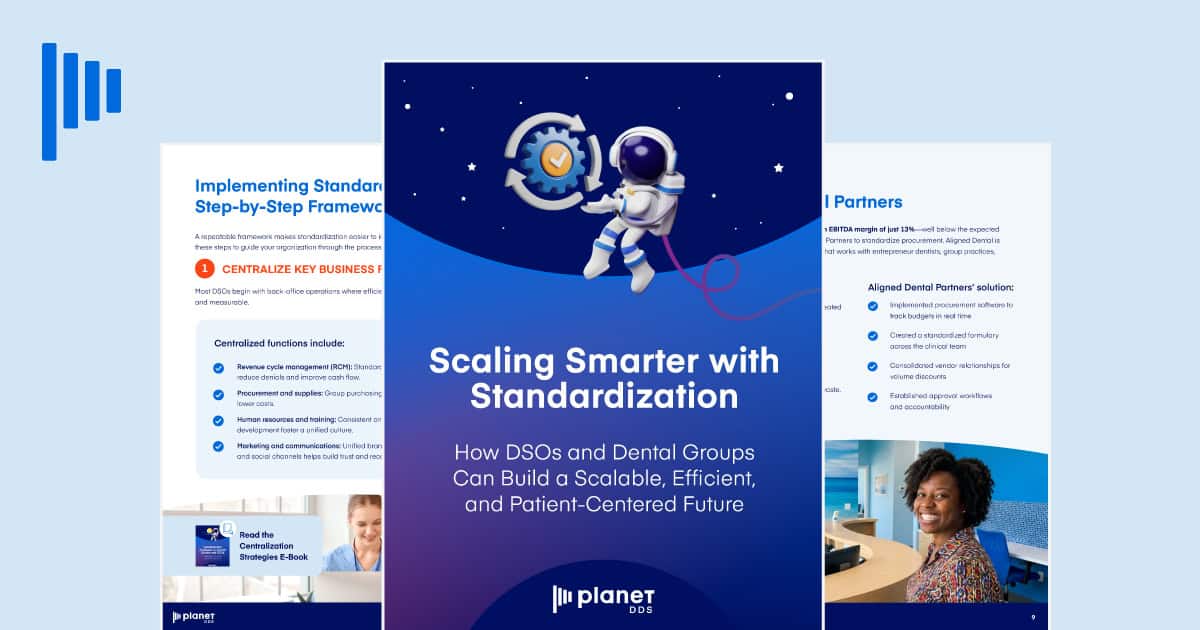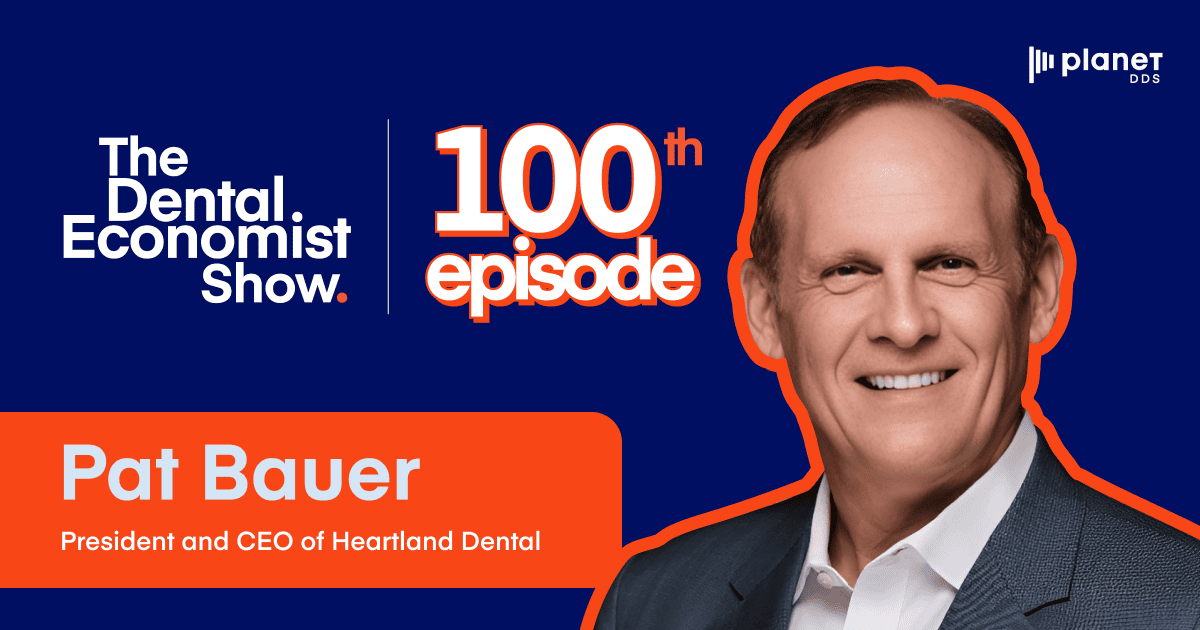All Things DSO: M&A Momentum and What to Expect for 2026

In the latest All Things DSO conversation, Planet DDS Editor-in-Chief Beth Gaddis sat down with Brian Colao, Director of Dykema DSO Industry Group, to unpack the state of dental M&A, interest rate tailwinds, consolidation trends, and the evolving priorities of investors. While 2025 hasn’t brought fireworks, Colao sees foundations being laid for a meaningful recovery heading into 2026.
“A lot is happening behind the scenes,” Colao noted. “By year’s end, I expect some exciting announcements that will build real momentum.”
From seasoned EBITDA to insurance reform, here are the key trends shaping the dental industry.
Interest Rate Relief: A Turning Point for M&A?
Just one day before the webinar, Federal Reserve Chair Jerome Powell hinted at additional rate cuts before year-end. Colao didn’t mince words: “I’d be shocked if we don’t see two more cuts.” Taken together with previous reductions, he believes we’re nearing a more favorable financing environment, which is much-needed fuel for stalled deals.
While 2025 may still feel tepid, Colao predicts 2026 will benefit from a more liquid M&A market: “Slow and steady wins the race. I’m very optimistic about next year.”
Consolidation Picks Up
Heartland Dental’s acquisition of Smile Design Dentistry, a dental group based in Florida with about 60 locations, captured industry attention. Colao emphasized this wasn’t an isolated move, but the re-start of a trend temporarily paused by market conditions.
“We’ve always known the big DSOs wouldn’t just acquire groups with just one or two practices,” Colao said. “They’re also targeting mid-market platforms with 25, 40, and 70 locations. Heartland is disciplined. If it makes sense, they’ll move.”
“Expect more large-scale consolidations as well-capitalized groups seek strategic opportunities,” said Colao said.
Centralization and Cutbacks: The Post-Merger Reality
One audience question cut to the operational heart of consolidation: “What happens to centralized services and executive roles during mergers?”
Colao’s answer was blunt but realistic. When a larger DSO acquires a smaller one, “You cut as much overhead as possible,” revealed Colao. He shared an example of a 30-location group with $5 million in corporate overhead, nearly all of which was eliminated post-acquisition. While the practice-level teams typically remain intact, the back-office infrastructure is often absorbed, instantly supercharging EBITDA.
Deal Drag: Why Some DSOs Aren’t Closing
Not all deals are moving forward. Key reasons include:
- Interest rate uncertainty: Even with expected cuts, rates remain a drag on large transactions.
- Unsustainable or “seasoned” EBITDA: Buyers are scrutinizing whether earnings are repeatable, not just historical.
- Technology fragmentation: Multiple practice management systems can hurt valuation. “If you’re using three PMS platforms, some buyers immediately discount or walk away,” explained Colao.
A lack of data cohesion and system consolidation also can make some investors hesitate or abandon a deal.
Public Market Activity: A Sign of Maturity
In Canada, GTCR’s acquisition of Dentalcorp marked one of the year’s most notable transactions. Colao applauded the move, noting that exiting public markets gives Dentalcorp more strategic freedom.
In the U.S., Park Dental Partners’ recent IPO, a relatively small $20 million raise, signals that public offerings aren’t reserved solely for billion-dollar DSOs. Still, Colao expects the next wave of IPOs will come from the largest companies in the sector.
“With massive platforms, there’s only so long you can grow privately. Going public becomes the logical option,” said Colao.
Regulatory Pressure and Insurance Reform
Both the ADA and ADSO have driven unprecedented progress in dental insurance legislation: Thirty-seven reforms passed in 2025 alone. Two areas dominate:
- Medical loss ratios (MLRs): This requires insurers to prove dollars flow to patient care, not overhead.
- Virtual credit card rules: Mandates opt-in rather than default enrollment to avoid hidden merchant fees.
AI regulation is emerging too, particularly regarding payer-side adjudication. While Colao supports AI in clinical decision support, he cautioned strongly against insurers using AI to identify claim denials.
Same-Store Growth: What Investors Really Want
Investors no longer reward expansion alone. They’re examining same-store performance within the past 12 to 24 months, not data from five years ago. According to Colao, investors look for growth across three levers:
- New patients
- More services per patient (for example: ortho, whitening, implants)
- Overhead reductions and operational efficiency
“If you’re thriving in difficult times like 2023 through 2025, that’s what excites investors,” Colao said.
Bank Financing: Easier for Smaller, Founder-Led Groups
Interestingly, smaller doctor-owned groups with personal guarantees still attract favorable lending terms. The challenge lies with mid-size DSOs that don’t want to provide personal guarantees but haven’t reached top-tier performance.
“Banks know they can’t liquidate a DSO like a house,” Colao warned. “If leadership falters, it’s a two-year recovery.”
Is Now the Time to Sell?
“It depends,” Colao reiterated about when to sell. “If your payer mix is healthy, culture strong, technology unified, and growth story compelling, 2026 may be ideal. If not, reinvest in operational readiness.”
Looking Ahead to 2026
Colao summed it up with cautious optimism: “We may not set records, but I’m very optimistic. I could see a huge comeback if conditions align. But more likely, we’ll see steady, sustainable improvement.”
The industry is rebuilding, not retreating. For DSOs, the winners will be those investing today in discipline, data, and resilience.
Ready to position your DSO or dental group for what’s ahead? Contact us today to learn how our cloud-based dental solutions can support your next phase of growth.



